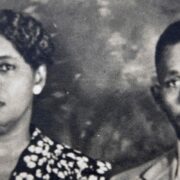Law enforcement knew who killed Harry and Harriette Moore on Christmas in 1951. So why wasn’t justice served?
— History.com
It was a double celebration: Christmas, and the Moores’ 25th anniversary. Harry T. and Harriette Moore celebrated the way they had 25 years before, cutting the cake together like newlyweds. They had no idea that the tender moment would be among their last. As they settled in to their bed to sleep that evening in 1951, a massive explosion tore through their bedroom.
Within hours, Harry T. Moore was dead. Within days, his wife was, too. With the death of the Moores, the nascent Civil Rights Movement got its first martyrs.
Read Full Article @ History.com
— Related
Jim Crow laws were state and local laws that enforced racial segregation in the Southern United States. These laws were enacted in the late 19th and early 20th centuries by white Southern Democrat-dominated state legislatures to disenfranchise and remove political and economic gains made by black people during the Reconstruction period. The Jim Crow laws were enforced until 1965.
In practice, Jim Crow laws mandated racial segregation in all public facilities in the states of the former Confederate States of America and in some others, beginning in the 1870s. Jim Crow laws were upheld in 1896 in the case of Plessy vs. Ferguson, in which the U.S. Supreme Court laid out its “separate but equal” legal doctrine for facilities for African Americans. Moreover, public education had essentially been segregated since its establishment in most of the South after the Civil War in 1861–65.
The legal principle of “separate but equal” racial segregation was extended to public facilities and transportation, including the coaches of interstate trains and buses. Facilities for African Americans were consistently inferior and underfunded compared to facilities for white Americans; sometimes, there were no facilities for the black community. As a body of law, Jim Crow institutionalized economic, educational, and social disadvantages for African Americans living in the South.
Jim Crow laws and Jim Crow state constitutional provisions mandated the segregation of public schools, public places, and public transportation, and the segregation of restrooms, restaurants, and drinking fountains between white and black people. The U.S. military was already segregated. President Woodrow Wilson, a Southern Democrat, initiated the segregation of federal workplaces in 1913.
In 1954, segregation of public schools (state-sponsored) was declared unconstitutional by the U.S. Supreme Court under Chief Justice Earl Warren in the landmark case Brown v. Board of Education. In some states, it took many years to implement this decision, while the Warren Court continued to rule against the Jim Crow laws in other cases such as Heart of Atlanta Motel, Inc. v. United States (1964). Generally, the remaining Jim Crow laws were overruled by the Civil Rights Act of 1964 and the Voting Rights Act of 1965.

